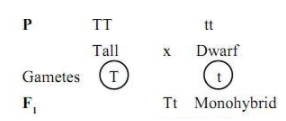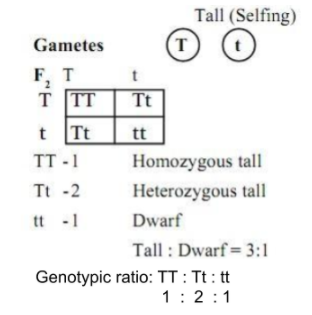
In a monohybrid cross, the genotypic ratio of the offspring in F2 generation is
A) 3:1
B) 1:2:1
C) 1:1:1:1
D) 4:0
Answer
575.1k+ views
Hint: In a monohybrid cross, the genotype of the F2 offspring appears in homozygous dominant, heterozygous and homozygous recessive forms.
Complete answer:
Mendel gave us an insight into the inheritance pattern of traits through various crosses he performed on the garden pea plant. One of such crosses is a monohybrid cross, that depicts the pattern of inheritance of a single gene with two alleles, controlling a single character with two traits.
In a monohybrid cross, a single character is studied. Say for example, the height of the pea plant. The character of height shows two traits, namely tall and dwarf. The gene controlling the height is depicted as T/t. The allele ‘T’ is responsible for tallness while the allele ‘t’ confers dwarf traits to the plants.
The parents for the cross are chosen as purebred or homozygous for the traits. It means, the tall parent plant will have both the alleles for ‘T as ‘TT’ in the genotype. The dwarf parent plant will have both the alleles for ‘t’ as ‘tt’ in the genotype.
The cross between a ‘TT’ and ‘tt’ parents are shown below:

Now, the F1 generation has all the tall plants but these are heterozygous, which means that they have two different alleles for a character. The ‘T’ allele is dominant here, so that’s why all the plants are tall.
In next step, Mendel performed the self-fertilization or selfing of the F1 generation plants as follows:

So, in F2 generation, we see two types of plants, tall and dwarf that appear phenotypically in the ratio 3:1. But genotypically, the tall plants are of two types, homozygous tall (TT) and heterozygous tall (Tt), therefore, the genotypic ratio comes out to be 1:2:1.
Therefore, the correct answer is option B.
Note:The result of F1 generation explains the Law of Dominance while that of F2 explains the Law of segregation. The F1 generation being all tall despite being heterozygous explains the dominant feature of the allele ‘T’ over ‘t’ of the gene T/t. The fact that none of the parents of the F2 were dwarf, yet the dwarf plant was obtained in F2 explains that in a heterozygous individual, both the different alleles segregate from each other while gamete formation.
Complete answer:
Mendel gave us an insight into the inheritance pattern of traits through various crosses he performed on the garden pea plant. One of such crosses is a monohybrid cross, that depicts the pattern of inheritance of a single gene with two alleles, controlling a single character with two traits.
In a monohybrid cross, a single character is studied. Say for example, the height of the pea plant. The character of height shows two traits, namely tall and dwarf. The gene controlling the height is depicted as T/t. The allele ‘T’ is responsible for tallness while the allele ‘t’ confers dwarf traits to the plants.
The parents for the cross are chosen as purebred or homozygous for the traits. It means, the tall parent plant will have both the alleles for ‘T as ‘TT’ in the genotype. The dwarf parent plant will have both the alleles for ‘t’ as ‘tt’ in the genotype.
The cross between a ‘TT’ and ‘tt’ parents are shown below:

Now, the F1 generation has all the tall plants but these are heterozygous, which means that they have two different alleles for a character. The ‘T’ allele is dominant here, so that’s why all the plants are tall.
In next step, Mendel performed the self-fertilization or selfing of the F1 generation plants as follows:

So, in F2 generation, we see two types of plants, tall and dwarf that appear phenotypically in the ratio 3:1. But genotypically, the tall plants are of two types, homozygous tall (TT) and heterozygous tall (Tt), therefore, the genotypic ratio comes out to be 1:2:1.
Therefore, the correct answer is option B.
Note:The result of F1 generation explains the Law of Dominance while that of F2 explains the Law of segregation. The F1 generation being all tall despite being heterozygous explains the dominant feature of the allele ‘T’ over ‘t’ of the gene T/t. The fact that none of the parents of the F2 were dwarf, yet the dwarf plant was obtained in F2 explains that in a heterozygous individual, both the different alleles segregate from each other while gamete formation.
Recently Updated Pages
Master Class 12 Business Studies: Engaging Questions & Answers for Success

Master Class 12 Economics: Engaging Questions & Answers for Success

Master Class 12 English: Engaging Questions & Answers for Success

Master Class 12 Maths: Engaging Questions & Answers for Success

Master Class 12 Social Science: Engaging Questions & Answers for Success

Master Class 12 Chemistry: Engaging Questions & Answers for Success

Trending doubts
What is meant by exothermic and endothermic reactions class 11 chemistry CBSE

Which animal has three hearts class 11 biology CBSE

10 examples of friction in our daily life

One Metric ton is equal to kg A 10000 B 1000 C 100 class 11 physics CBSE

1 Quintal is equal to a 110 kg b 10 kg c 100kg d 1000 class 11 physics CBSE

Difference Between Prokaryotic Cells and Eukaryotic Cells




